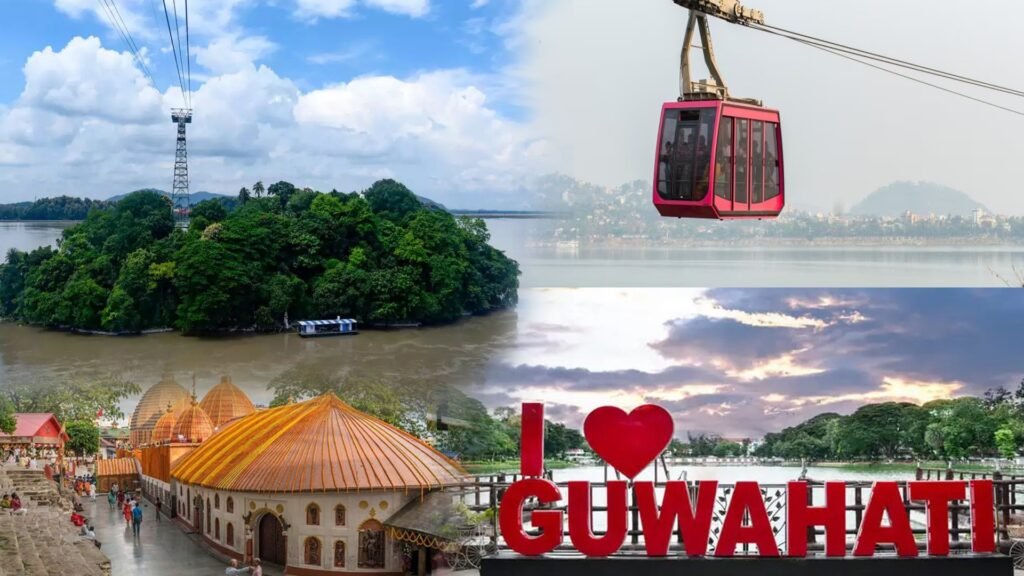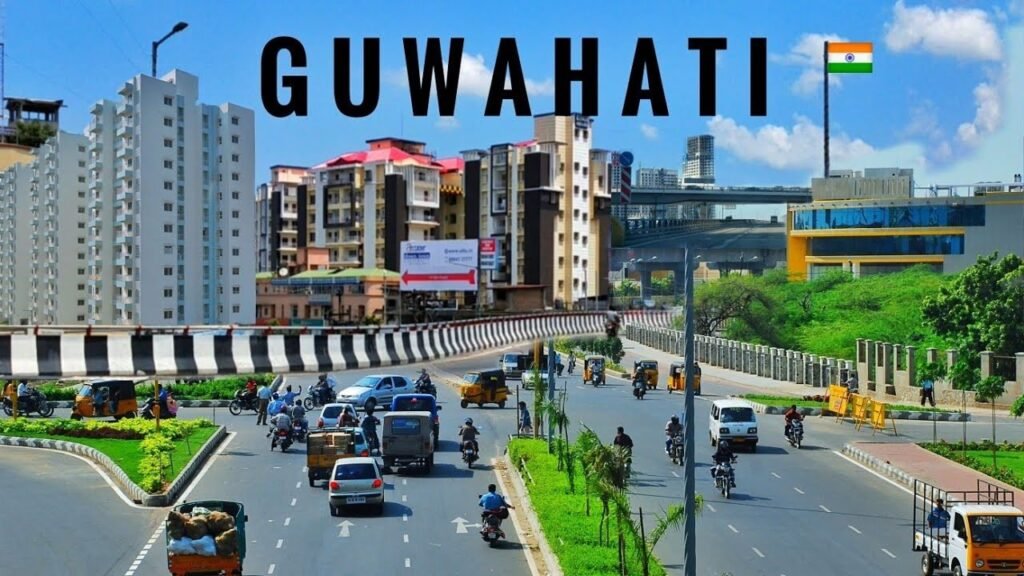Guwahati, the largest city in Assam and the gateway to Northeast India, beautifully blends ancient history, rich cultural heritage, natural beauty, and rapid urban development. Nestled on the southern banks of the mighty Brahmaputra River, Guwahati is a city with a rich history that spans thousands of years, serving as a cultural and commercial hub in the region.
Location and Connectivity
Strategically located on the south bank of the Brahmaputra, Guwahati serves as the commercial and transportation hub for Assam and the broader Northeast region. It connects six northeastern states: Arunachal Pradesh, Nagaland, Manipur, Meghalaya, Mizoram, and Tripura, acting as a vital gateway.
The city is well-connected by air via Lokpriya Gopinath Bordoloi International Airport, by rail with broad-gauge connections, and via road networks that link to other major Indian cities and northeastern states.
Key Details:
| Feature | Overview / Details | Best Visiting Time | Estimated Cost (INR) |
|---|---|---|---|
| Location | Diverse (Assamese, tribal), Bihu and Durga Puja festivals, and silk weaving | Year-round, peak: Oct-Mar | N/A |
| Population | Approx. 1.1 million (2020) | N/A | N/A |
| Main Attractions | Kamakhya Temple, Umananda Island, Assam State Museum, Srimanta Sankaradeva Kalakshetra | Oct-Mar (for festivals, weather) | Included in tours |
| Culture | Year-round, avoid the monsoon | Oct-April (Bihu, Puja) | N/A |
| Climate | Subtropical, with pleasant winters (10-25°C) | Oct-April (pleasant) | N/A |
| Accessibility | Flights (Lokpriya Gopinath Bordoloi Airport), trains, buses, cabs, river cruises | Year-round, less rain is better | Flight: ₹5,000–₹12,000 (round trip) |
| Accommodation | Budget: Hostels/guesthouses; Mid-range & luxury hotels | Year-round | ₹800–₹12,000/night |
| Local Transport | Cabs, autos, app-based taxis, bus services | Year-round, less rain better | ₹200–₹1,000/trip |
| Guide/Land Package | Day tours, sightseeing cabs, packaged multi-day tours | Oct-April (outdoors/events) | ₹2,599–₹5,999/day (cab tour) |
| Tour Packages | 2–7 nights (Guwahati, Shillong, Kaziranga, etc.) | Oct-Mar (comfortable) | ₹10,000–₹60,000/person-total |
| Festival Season | Bihu (April), Ambubachi Mela (June/July), Durga Puja (Oct), Brahmaputra Fest (Jan/Feb) | See festival | N/A |
| Off Season | Monsoon (June–Sep), high rain, less crowded, lush green | June–Sept | Discounts on stays/tours |
Key Insights:
- Peak tourist season, from October to March, offers the most comfortable weather, with pleasant daytime temperatures and major festivals.
- Budget Range: Solo city trips (excluding flight): Budget (₹10,000–₹15,000), Mid-range (₹20,000–₹30,000), Luxury (₹40,000–₹60,000) per person for ~4-5 nights, including stays, local transport, and sightseeing.
- 1-Day Sightseeing Tours: Local cabs for full-day sightseeing typically range from ₹2,500 to ₹6,000, depending on the car size and distance.
- Accommodation: Wide variety, from budget hostels to luxury hotels and eco-resorts.
History of Guwahati
The city’s history is deeply rooted in mythology, ancient kingdoms, and colonial legacies. Originally known as Pragjyotishpura, Guwahati was the capital of the ancient Hindu kingdom of Kamarupa around 400 CE. The name Pragjyotishpura, derived from astrology, reflects the city’s early prominence as a centre of knowledge and power. Archaeological excavations at Ambari trace habitation back to at least the 6th century CE, confirming Guwahati’s long-standing significance.
Guwahati witnessed rule under various dynasties, including the Varman and Pala rulers, who upheld it as Assam’s capital until the 10th or 11th century CE. The city later became an important military and administrative centre under the Ahoms, a Tai-speaking people who ruled Assam for nearly 600 years. During the 17th century, Guwahati frequently changed hands amidst conflicts involving the Mughals, Ahoms, and Burmese until it stabilised under Ahom governance.
One of the most defining historical moments linked to Guwahati is the Battle of Saraighat (1671), where the Ahom general Lachit Borphukan led a remarkable victory over Mughal invaders near the city, safeguarding Assam’s sovereignty.
Under British colonial rule, Guwahati was an important administrative centre until the capital moved south to Shillong in 1874. Since then, the city has grown rapidly and developed into a commercial and cultural nucleus of Northeast India.
Culture and People
Guwahati exudes a vibrant cultural atmosphere, home to a mix of ethnic groups including Indo-Burmese, Mongolian, Aryan, and Indo-Iranian communities. The majority of its inhabitants practice Hinduism, but various other religions, including Buddhism, Islam, Christianity, Jainism, and Sikhism, contribute to the city’s multicultural fabric.
Assamese (Asomiya) is the primary language spoken, alongside regional languages such as Bodo, Rabha, Karbi, and Mishing. The people of Guwahati are known for their hospitality, simplicity, and warmth, making it a welcoming destination for visitors.
Cultural life flourishes through festivals such as Bihu, marking the Assamese New Year; Ambubachi Mela, tied to the Kamakhya Temple; and the Brahmaputra Beach Festival. Traditional dance forms, such as Bihu and Sattriya, alongside local arts and crafts like silk weaving (notably Muga and Eri silk), showcase the region’s rich artistic heritage.
Top Tourist Spots
Guwahati attracts tourists with its stunning scenic beauty, rich historical temples, and diverse wildlife sanctuaries. Key attractions include:
- Kamakhya Temple: A major Hindu pilgrimage site atop Nilachal Hill, famed for its tantric traditions and annual Ambubachi Mela.
- Umananda Island, located on the Brahmaputra River, is the smallest inhabited riverine island in the world.
- Assam State Museum: Showcasing Assam’s rich history, art, and culture.
- Srimanta Sankaradeva Kalakshetra: A cultural complex dedicated to Assamese art, dance, and crafts.
- Brahmaputra River Cruise: Offering breathtaking views of the sunrise and sunset over the mighty river.
- Pobitora Wildlife Sanctuary: Known for one of the highest densities of the Indian one-horned rhinoceros.
- Navagraha Temple: Devoted to the nine celestial bodies in Hindu astrology.
- Deepor Beel: A wetland sanctuary famous for bird watching.
These sites offer a blend of spiritual reverence, natural splendour, and cultural experiences, making Guwahati a premier destination in Northeast India.

Revenue and Economy
Guwahati’s economy is diverse, driven by commerce, industry, and services. The city is home to an oil refinery and various industries, including those related to tea processing, agriculture, and soap manufacturing. It also functions as a key river port facilitating trade along the Brahmaputra.
Rapid urbanisation and population growth have spurred real estate, retail, and educational sectors, with institutions like Gauhati University and the Indian Institute of Technology (IIT) Guwahati enhancing the city’s educational profile.
The commercial vibrancy attracts businesses, contributing to the revenue of the Kamrup Metropolitan district and supporting the city’s expansion.
FAQs About Guwahati
What is the history behind Guwahati’s name?
The name “Guwahati” combines the Assamese words “Guwa” (areca nut) and “Haat” (market), signifying a marketplace where areca nuts were traded. Historically, the city was known as Pragjyotishpura, an ancient capital deeply rooted in astrology and mythology.
What is the significance of the Kamakhya Temple?
Kamakhya Temple is a major Hindu pilgrimage centre dedicated to the goddess Kamakhya. It is renowned for its tantric worship and the annual Ambubachi Mela festival, which draws thousands of devotees from around the world.
How can tourists reach Guwahati?
Guwahati is accessible by air through its international airport, by broad-gauge railways connecting it to major cities, and well-maintained roadways linking it to the rest of Assam and neighbouring northeastern states.
What are the major cultural festivals celebrated in Guwahati?
Notable festivals include Bihu, marking the Assamese New Year; Ambubachi Mela at the Kamakhya Temple; and the Brahmaputra Beach Festival, reflecting the city’s rich traditions and religious heritage.
Which wildlife sanctuary near Guwahati is popular among tourists?
Pobitora Wildlife Sanctuary is famous for hosting one of the highest densities of the Indian one-horned rhinoceros, making it a favoured destination for nature lovers and wildlife enthusiasts.
What role does Guwahati play in the economy of Northeast India?
As Assam’s principal commercial centre, Guwahati supports industries such as tea processing, oil refining, agriculture, education, and trade, making it a significant economic powerhouse in the region.
